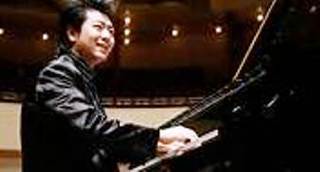|
Back
Alpha and Omega, Minor and Major New York
Isaac Stern Auditorium, Carnegie Hall
05/11/2016 - & May 12, 13, 14, 2016 (Philadelphia)
Sergei Rachmaninoff: Piano Concerto No. 1 in F-sharp minor, Opus 1
Gustav Mahler: Symphony No. 10 in F-sharp Major (Deryck Cooke performing edition)
Lang Lang (Piano)
Philadelphia Orchestra, Yannick Nézet-Séguin (Music Director and Conductor)

Y. Nézet-Séguin (© The Philadelphia Orchestra)
It was literally, the Alpha and the Omega, the Major and the Minor of music last night. The Philadelphia Orchestra started with Rachmaninoff’s Opus 1 in F-sharp minor, and finished with the final opus of Gustav Mahler, the unfinished 10th Symphony in F-sharp Major.
The Rachmaninoff was started in 1890 and revised in 1917, the Mahler was started in 1910, and was finished in 1967 by Deryck Cooke. Stylistically, the Rachmaninoff First Concerto could have been written 30 years earlier, the Mahler was teetering on Schoenberg’s breakup of everything from the Nineteenth Century.
What the two works had in common was the always reliable Philadelphia Orchestra and their dynamically exacting music Director, Yannick Nézet-Séguin. Perhaps he was undercut by the emotionally exciting Lang Lang in the concerto, but after the intermission, his Mahler made one forget entirely about the soloist.

L. Lang(© Courtesy of the Artist)
That’s a shame, though. Lang Lang has become better and better since his first recitals and concerts. From the beginning, he has been a technical prodigy, a young man bent on giving every piece of music every shred of his considerable energy and digital power.
At times, this was unnerving. He once played Pictures at an Exhibition with everything right–except the pictures themselves. It was superb piano playing, mediocre music. Another time, he did Gershwin’s Rhapsody In Blue, without any consideration that Gershwin wanted this as serious music. Instead, he broadened it, gave it unneeded jazzy syncs and made it Lang Lang’s Rhapsody.
He has learned much since those days, though his Rachmaninoff First was a fitting vehicle for his wondrous digital dexterity. The composer revised it several times, though this 1917 production still sounds hammered together. But within those segments, a pianist like Lang Lang can use every titanic force at his disposal. The entire first movement sounds like a cadenza for him, and he played it with sizzling accuracy.
Was one disconcerted by his floating hands, his smiles, his dramatic composure? Well, no. After all, this is his honest enthusiastic character. Were we worried when the Andante was given an Adagio tempo? Not at all. Lang Lang seems to believe that the Rachmaninoff is an extended Chopin nocturne, and the conductor was happy to go along with him.
In other words, this peppy, delightful still young pianist is ready to mold composers to his own image. And while one might regret the excessive retards, the lack of anything Russian or even soulful, Lang Lang has the chops–and the future–to transform his electrifying vehicles into music which complements the composer.
One hardly needed excuses for Mr. Nézet-Séguin’s performance of Mahler’s Tenth last night. Rather, the Deryck Cooke “performing version” of the symphony. The difference between those words and “completion” were probably literal to the late British musicologist. But to the audience, this was indeed an authentic–sounding completion of a work for which the composer had completed only the first movement, with extended sketches for the rest.
The 75 minutes, beginning with the most stunning viola start of any work, was too much for some in the audience, who walked out. How they could have dared do that after the huge climax of the first movement is bewildering. Mr. Nézet-Séguin led the Philadelphia Orchestra, with their lush strings with an inexorable gorgeousness. In fact, so beautiful was their playing that the grand chords in the middle, what sounded like the orchestration of a huge organ, was less a scream of pain from the ailing composer than a reaching out to the Almighty with–dare I say it?–joy.
After this, the Mahler contradictions began to jut out. The two scherzos, both mordant, quirky, funny, eccentric, a kind of Divine Comedy. And then the Mahler-Cooke finale. Cooke modestly said that Mahler would have “expanded, contract, redistributed, added or cancelled”. But one could have said the same thing with the completion of Mozart’s Requiem. (And thankfully, nobody has tried to complete Schubert’s ”unfinished”.)
This climax did sound authentic, meaningful, paradoxical in style. Yet the final measures were luminous and majestic. Yannick Nézet-Séguin and his orchestra gave those Omega moments a glowing Alpha nobility.
Harry Rolnick
|